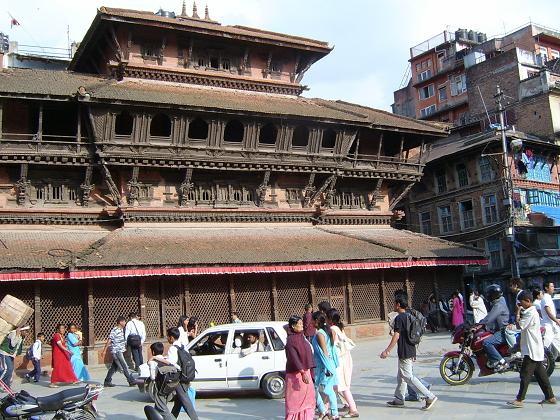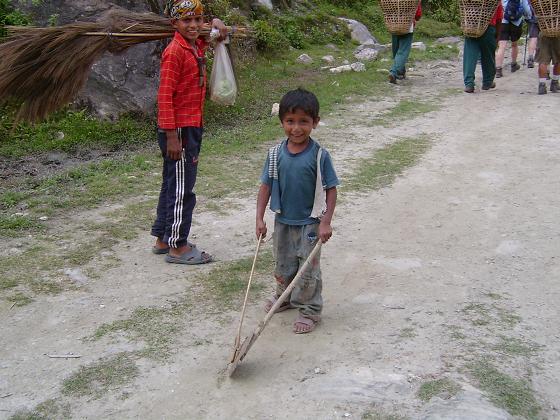Made this trekking holiday in April 2007, it started with an overnight flight to Kathmandu via Doha and all walking was to be at a leisurely pace following well-worn paths.
 We were to be travelling between mountain lodges which involved daily distances of an average of six to thirteen kilometres. Plenty of opportunities to take a short break, and most of the trekking will be in the morning so arriving at the next lodge in time for lunch. Afternoons are at leisure.
The highest altitude at which we would trek is around 1,980 metres, most other walks are at between 1,070 and 1,680 metres. Only need to carry a small backpack.
Each of the mountain lodges at which we stayed promised spectacular views, traditional décor and a warm welcome. Each lodge has a dining room and an area with an open fire, and guest rooms have private facilities with a shower. Each has electricity and, to further cheer us, a free bar serving a limited selection of local beer, spirits and soft drinks for one hour each evening, usually from 6pm until 7pm.
We were to be travelling between mountain lodges which involved daily distances of an average of six to thirteen kilometres. Plenty of opportunities to take a short break, and most of the trekking will be in the morning so arriving at the next lodge in time for lunch. Afternoons are at leisure.
The highest altitude at which we would trek is around 1,980 metres, most other walks are at between 1,070 and 1,680 metres. Only need to carry a small backpack.
Each of the mountain lodges at which we stayed promised spectacular views, traditional décor and a warm welcome. Each lodge has a dining room and an area with an open fire, and guest rooms have private facilities with a shower. Each has electricity and, to further cheer us, a free bar serving a limited selection of local beer, spirits and soft drinks for one hour each evening, usually from 6pm until 7pm.
Day 2 Kathmandu
The first night was at Dwarika's Hotel which is a unique establishment with a very interesting history. Its founder became committed to preserving Nepalese culture after finding two men sawing exquisite centuries old carvings for firewood. he bought the men new timber in exchange for the old wood and from that point embarked on a lifelong campaign.
As his collection grew it occurred to him that building a hotel incorporating the rescued treasures would both preserve the Nepalese heritage and provide an income to fund the continuing work. Dawikas Hotel is the embodiment of that dream and living proof that tourism need not destroy heritage.
Day 3 Kathmandu to Birethanti
The next day was an early start for the journey to the airport and the short flight to Pokhara, this was to be the start of the trek.
Pokhara, the rural capital of Western Nepal, is at a lower elevation than Kathmandu, and the terrain reflects this with an almost tropical setting of lush forests, emerald lakes and a proliferation of vividly coloured flowers. as it is the base from which most treks start, the city has a transient population and there is almost a tangible buzz of anticipation.
 The trek which started after a short bus ride, was at an easy pace walk along the lower foothills, stopping for lunch before arriving at Sanctuary Lodge for an over-night stay.
The trek which started after a short bus ride, was at an easy pace walk along the lower foothills, stopping for lunch before arriving at Sanctuary Lodge for an over-night stay.
From the lodge there were magnificent views of Fishtail Mountain or Machhapuchhre, as it is locally known.
Day 4. Birethanti to Ghandruk
Today’s hike is more strenuous with some steep slopes as it took us past outlying farms and up the Modi River Valley. The trek was broken with brief stops for snacks, passing through small villages, past terraced rice paddies and through leafy forests, eventually reaching the farming village of Ghandruk.
A late lunch was served upon your arrival at the Himalaya Lodge, where we stayed for two nights. Now at a height of approximately 1,982 metres, so the rest was well deserved.
This evening you we enjoyed the usual ‘happy hour’ and dinner followed by the nightly briefing.
Day 5. Ghandruk
Up early to enjoy the sunrise and after breakfast we walked in to the nearby village which is well known for the traditional rugs woven by the womenfolk.
This area also has a strong association with the British Army. The Nepalese are noted for their bravery as soldiers, and many of the local men join the ranks of the Gurkha regiment. The kingdom has benefited from this in two major areas. Over years of training, the men have acquired and brought back many non-combatant skills, and the foreign currency brought into the country by way of subsistence and pensions has been of great benefit to the economy.
After exploring some of the local countryside, we made our way back to the lodge in time for lunch and an afternoon spent relaxing.
Day 6. Ghandruk to Birethanti
Leaving the lodge, we made our way back through the village and down to the Modi River, passing the village of Kimche en route. The destination was Sanctuary Lodge, which we reached in time for lunch.
 Later, children from the local school visited the lodge and performed a number of local dances and songs typical of the region.
Later, children from the local school visited the lodge and performed a number of local dances and songs typical of the region.
Day 7. Birethanti to Majhgaun
Set off today on a meandering path which follows the path of the Modi River. The trek took us across a cable bridge and a convoluted uphill path of steps, before leading to Gurung Lodge where we arrived in time for lunch.
 The lodge is built along the lines of a traditional Nepalese village and every room has spectacular views of Annapurna South and Hiunchuli.
After lunch, there was an opportunity to explore the nearby picturesque villages of Majhgaun and Patleket.
The lodge is built along the lines of a traditional Nepalese village and every room has spectacular views of Annapurna South and Hiunchuli.
After lunch, there was an opportunity to explore the nearby picturesque villages of Majhgaun and Patleket.
Day 9. Majhgaun to Pokhara
This morning’s trek was through sub-tropical forests where tree orchids, rhododendrons and magnolias thrive. We reached the Basanta Lodge in Dhampus in time for lunch, after which resumed the trek, walking downhill through wooded hillside and terraced farmland to the valley floor.
It is here that we boarded a minibus for the short journey to Pokhara.
Day 10 Pokhara
Pokhara lies in a valley in central Nepal, about 200 kilometres west of the capital. The town itself grew up almost 200 years ago at the intersection of Nepal's main north-south and east-west trade routes. Although it has since spread out along the valley, the town retains a village like atmosphere, and is renowned for its scenery and idyllic, peaceful atmosphere.
Day 11 Pokhara to Kathmandu
After lunch it was the flight back to Kathmandu and Dwarikas Hotel.
Day 12. Kathmandu
Early this morning, I took an optional mountain flight to view Mount Everest
Later, a half-day sightseeing tour of Kathmandu, ‘The City of Glory’. Amongst the places visited was Jhochhne Street, nicknamed Freak Street by the hippies who flocked to Kathmandu in the 1960s. Today it is more staid and respectable, but it remains one of the city’s main meeting places for travellers.
Visited Durbar Square, the ancient heart of Kathmandu and an excellent place to absorb the city’s unique atmosphere. The square contains more than 80 elaborate temples and monuments. The Kumari Bahal is home to the ‘living goddess’, a representative of the patron goddess Taleju. The young goddess lives here from the age of around six to puberty, leaving the house only to attend the frequent festivals. Also saw the statue of Hanuman, the revered monkey companion of Lord Rama.
Also made an independent visit to the cremation ghats beside the river, maybe a little macabre but what an experience
Day 13 Kathmandu to UK
Back to the UK today, again via Doha.
A truly wonderful experience among fantastic scenery.
Thank goodness for the porters who worked so hard carrying all our stuff.
Back to top of page